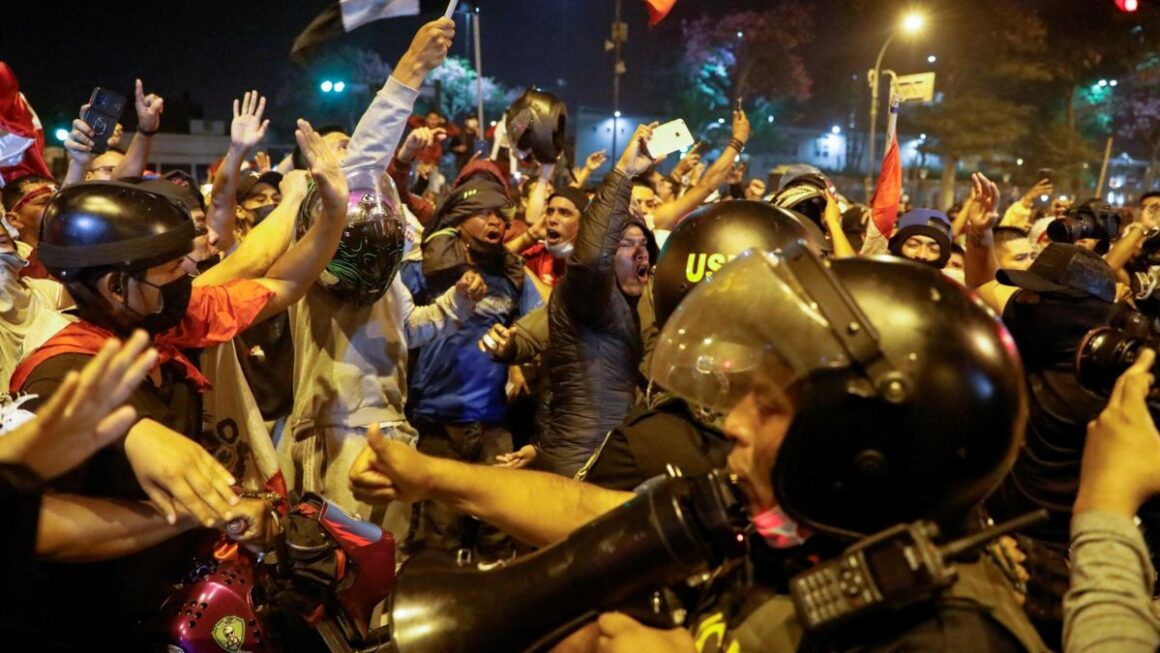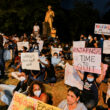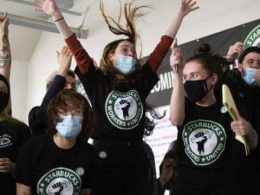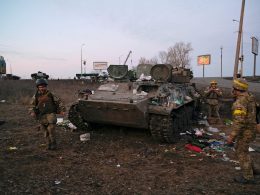By Darragh O’Dwyer
The impacts of the war in Ukraine are reverberating throughout the world, heaping more turmoil onto the global economy and spurring social and political crises. Ongoing protests and riots in Peru triggered by spiraling inflation have already left seven people dead and are a striking example of what’s in store in the current period of capitalist instability.
Less than a year into his presidency Pedro Castillo’s electoral slogan ‘Nobody should be poor in a rich country’ lies shattered in a thousand pieces. A rural teacher and trade unionist, Castillo was elected on a left program to tackle inequality and poverty through taxing the rich and nationalizating key industries. Although initially a complete outsider, Castillo routed his opponents by tapping into the discontent of the Peruvian masses, an electoral expression of the mass protests that erupted in November 2020.
But now, barely eight months later he confronts a movement of the working class and oppressed in response to deteriorating living conditions.
War and inflation
The immediate trigger for protests are hikes in fuel prices. Even prior to the war, Peru had been struggling to control inflation that saw the cost of living surge. Western sanctions on Russia and a lack of exports from the region have further disrupted global supply chains and pushed up prices on food, fuel and fertilizers — of which both Russia and Ukraine are major exporters.
Peru is not an isolated case. Sri-Lanka has erupted in protest over inflation and shortages and demonstrations on the same issues have rocked Albania and Sudan. While in some countries the war may have temporarily strengthened the establishment in the name of an already fraying national unity, elsewhere it is pulling apart the system at the seams.
Let them eat … Fish
The movement began with a strike called by the National Guild of Carriers and Drivers (GNTC) on 28 March to protest a rise in fuel prices which connected with a wider anger and detonated a broader struggle that spread throughout the entire country involving workers, farmers and youth.
Prime minister Anibal Torres had his Marie Antoinette moment when he claimed people should eat fish if they could not afford chicken — despite the former being more expensive. Such comments show nothing but disdain for the conditions faced by the Peruvian masses. On top of having the world’s highest per-capita death rate from COVID-19, the impact of the pandemic saw the poverty rate rise to 30%. The current increase in food costs are the boiling point: quantity turns to quality, accumulated misery explodes on to the streets.
Perhaps inevitably, aspects of the protests are characterized by an inchoate anger and sense of desperation. Toll bridges have been set on fire and supermarkets looted. But the workers’ movement has also played a significant role. Sutep, the main teachers union, called for Castillo — who hails from their own ranks — to “change course or resign” and appealed to workers and other organizations to continue to mobilize, demanding new elections and that “the rich pay the cost of the crisis.”
Government response: Concessions and repression
Likewise, when the government responded by promising to scrap the fuel tax and a 10% increase on the national minimum wage, the General Confederation of Peruvian Workers, correctly rejected the wage increase as insufficient, a drop in the ocean of meteoric price surges.
The movement has continued, and when it’s concessions had failed, the government switched to the implementation of martial law and the use of state repression. Yet even this failed to deter protesters. The government was forced back, lifting the curfew the next day, and demos, blockades and confrontations with police continue at the time of writing.
All of this points to an incredibly weak government, one that has attempted to straddle the increasingly narrow tightrope between appeasing the masses that brought it to power and not upsetting economic interests of the ruling elite. The contradictions are now unraveling.
Political instability in the Age of Disorder
Despite the huge expectations placed in the Castillo government to deliver real change, he has taken the path of class conciliation and ultimately accepting the confines of the capitalist system. While foreign investors and the Peruvian capitalists were initially terrified at the prospect of a left government, Castillo saw that business continued as usual and the mining sector remained in the hands of the profiteers. Since taking office, no nationalizations have taken place with Castillo resigning himself to managing capitalism.
Rather than being rewarded with even temporary stability, Castillo has stumbled from one crisis to the next, facing two impeachment attempts. Concessions to the right saw his own nominally Marxist party, Peru Libre, break ranks with the President. But even that was not enough to assuage the fears of the ruling class.
Politics, as Lenin said, is concentrated economics. And, in the ‘Age of Disorder’ the intractable contradictions of capitalism are reflected in increasingly dramatic political crises. As pointed out in a recent FT article that questioned whether Peru was becoming an ungovernable country: “Since taking office last July, the president has rattled through four cabinets, four prime ministers, three foreign ministers and two finance ministers . . . On average, Castillo has changed ministers every nine days.”
Amongst his base, Castillo’s honeymoon period was short lived. Even prior to the protests his support had sunk to 25%. Although Peru’s economy experienced 13.3 percent growth in 2021, one of the highest in the world, the gains were not felt by the working masses and poor. This growth also comes after an historic 11% contraction recorded in 2020
Threat of the far-right
Castillo’s government has faced a relentless campaign of sabotage by the right, politically, economically and ideologically. While his opponents are attempting to exploit the current situation and point to Castillo’s incompetence it’s also clear that they themselves are made deeply uncomfortable by the uprising and are unwillling to back it. They are all too aware that they are incapable of solving the current crisis.
Nevertheless to avoid co-optation, confusion and demoralization the movement needs to deepen its organization around a clear set of demands and maintain a position of class independence. We need only recall that Castillo narrowly beat out far-right candidate Keiko Fujimori — daughter of former dictator Alberto Fujimori — behind which the entire establishment threw their weight. Castillo’s election represented a victory over the far-right, but one that has not been fully consolidated. Fujimori’s supporters have continued to organize against the Castillo government and if anything the conditions have only become more fertile for their growth.
Way forward for the movement
We should look to the movement that took place in neighboring Ecuador in 2019 against IMF mandated cuts to fuel subsidies. Solidarity and united action amongst indigenous people and workers forced the government of Lenin Moreno to back down. Crucially it was the intervention of the working class — above all, transport workers — that brought the economy to a standstill and stalled the austerity reform.
Likewise in Peru, the current protests illustrate the strategic power of logistics workers and their ability to disrupt the economy. As elsewhere in Latin America, poor infrastructure means shutting down a single highway like the Pan-American Express can bring society to a halt and result in a hemorrhaging of profits of the major capitalists. The trade union movement should begin building for a general strike, not just amongst the small minority of workers already organized in their ranks, but also seek to mobilise and organise the millions of precariously employed and non-unionized sectors, alongside poor farmers, indigenous people and students as well as the LGBTQ and feminst movements.
This latent power needs to be organized around a political program that can point a way out of the crisis. An emergency tax on the super-rich and multinationals would go a long way to provide immediate relief to the poor and working masses. Price controls and a sliding scale of wages (to stay above inflation), an eviction moratorium and rent controls are all key. Community committees should be established to oversee distribution and root out price gouging.
Break with capitalism and imperialism
But as it becomes clearer everyday, a decaying capitalist system is incapable of providing these demands or any of life’s most basic necessities. That’s why we need to not just return to Castillo’s initial program to nationalize key mining companies but go further and demand the taking of the commanding heights of the economy into democratic public ownership, alongside a genuine agrarian reform that takes the land out of the hands of the major landlords and distributes it amongst poor farmers and indigenous people.
Of course, this would meet the bitter resistance of Peruvian capitalism and the various imperialist powers with interests in Peru. Neither Castillo or the leadership of his former Peru Libre party have proven willing to wage that battle and openly break with the rule of capital. Therefore the working class and oppressed who brought Castillo to power must fight for new instruments of struggle which go beyond a timid reformist outlook. As we pointed out in the wake of Castillo’s victory, and which remains even more relevant today:
“All the energy of the Peruvian masses must be organized to advance beyond the reforms proposed by Pedro Castillo. It must go towards the destruction of this capitalist state and advance in the construction of a workers’ government and build socialism in Peru and the rest of Latin America.”












